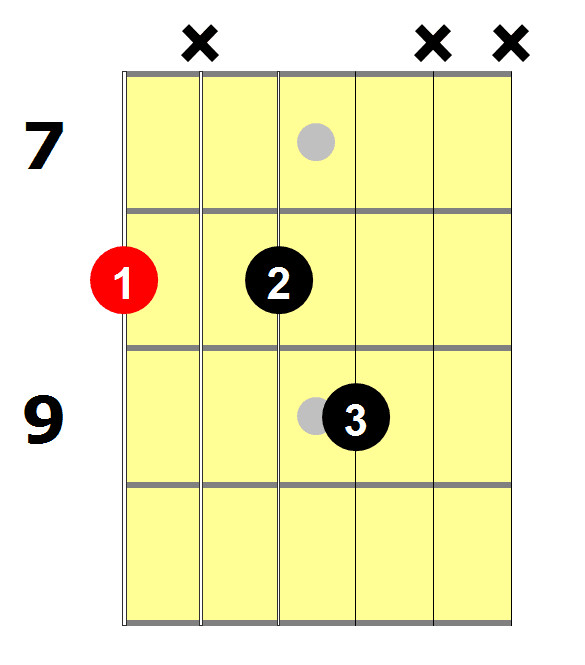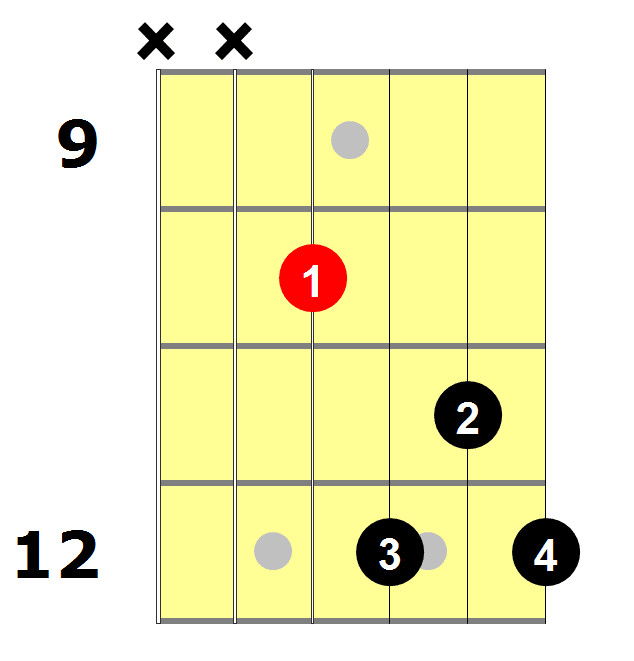The C7 Guitar Chord is a fantastic addition to any guitarist’s toolkit. Known for its bluesy and jazzy flavor, the C7 adds depth and character to your playing, moving beyond the standard C major. In this guide, we’ll explore multiple ways to play the C7 chord, delve into its musical theory, and provide practical tips to master it, enhancing your guitar skills and musical expression.
What is a C7 Chord? Understanding the Dominant 7th
Before diving into shapes, let’s understand what makes a C7 chord unique. It’s a dominant 7th chord, built upon a C major triad (C, E, G) with an added flat 7th (b7) note, which is Bb. This added note is what gives the C7 its distinctive, slightly dissonant, and bluesy sound compared to a regular C major chord.
Here’s the breakdown of notes in a C chord versus a C7 chord:
C Major Chord:
- Root: C
- Major 3rd: E
- Perfect 5th: G
C7 Chord:
- Root: C
- Major 3rd: E
- Perfect 5th: G
- Minor 7th (b7): Bb
This minor 7th interval creates a richer, more complex sound that is widely used in blues, jazz, rock, and many other genres.
Exploring 5 Essential C7 Guitar Chord Shapes
Let’s get practical and learn five effective ways to play the C7 chord on your guitar, starting from the easiest to more versatile shapes.
1. Open Position C7 Chord: The Beginner-Friendly Shape
This is often the first C7 chord shape beginners learn due to its accessibility. It utilizes open strings, making it easier to fret.
- Place your 1st finger on the 1st fret of the B string (2nd string).
- Place your 2nd finger on the 2nd fret of the D string (4th string).
- Place your 3rd finger on the 3rd fret of the A string (5th string).
- Place your 4th finger on the 3rd fret of the G string (3rd string).
- Strum from the A string (5th string) downwards.
This voicing is bright and clear, perfect for rhythm guitar in various styles.
2. C7 Barre Chord (E7 Shape): Moveable Power
Barre chords are fundamental for guitarists, offering moveable shapes up and down the neck. This C7 barre chord is based on the open E7 chord shape.
First, visualize the E7 shape:
Now, transform it into a C7:
- Barre your 1st finger across all six strings at the 8th fret.
- Place your 2nd finger on the 9th fret of the G string (3rd string).
- Place your 3rd finger on the 10th fret of the A string (5th string).
This shape is powerful and versatile, allowing you to play C7 and other 7th chords across the neck by simply moving this shape.
3. C7 Barre Chord (A7 Shape): Another Moveable Option
Similar to the E7 shape, we can adapt the open A7 chord shape into a moveable C7 barre chord.
Start with the A7 shape in mind:
Now, create the C7:
- Barre your 1st finger across all six strings at the 3rd fret.
- Place your 3rd finger on the 5th fret of the D string (4th string).
- Place your 4th finger on the 5th fret of the B string (2nd string).
- Strum from the A string (5th string) downwards.
This voicing is slightly different from the E7 shape C7, offering tonal variety. For an easier variation:
- Place your 1st finger on the 2nd fret of the D string (4th string).
- Place your 2nd finger on the 3rd fret of the A string (5th string).
- Place your 3rd finger on the 3rd fret of the G string (3rd string).
(This is very similar to the open position C7, but slightly different fingering)
4. 3-Finger C7 Chord: Low-End Grit
For a chunkier, low-end focused C7 sound, this 3-finger voicing is ideal, especially for rhythm guitar in genres like blues and rock.
 C7_small_version
C7_small_version
- Place your 1st finger on the 8th fret of the low E string (6th string).
- Place your 2nd finger on the 8th fret of the D string (4th string).
- Place your 3rd finger on the 9th fret of the G string (3rd string).
- Strum from the low E string (6th string) downwards, potentially skipping the A string for a tighter sound.
This shape delivers a powerful root and fifth, with the 7th adding harmonic color without being too bright.
5. C7 Barre Chord (D7 Shape): High and Bright
This C7 voicing, derived from the D7 shape in the CAGED system, offers a brighter, higher-register sound, great for lead guitar or adding sparkle to rhythm parts.
Visualize the D7 shape:
Now, adapt it to C7:
 C7 guitar chord
C7 guitar chord
- Place your 1st finger on the 10th fret of the D string (4th string).
- Place your 2nd finger on the 11th fret of the B string (2nd string).
- Place your 3rd finger on the 12th fret of the G string (3rd string).
- Place your 4th finger on the 12th fret of the high E string (1st string).
- Strum from the D string (4th string) downwards, or strum all strings for a fuller sound.
This voicing is higher up the neck, providing a different tonal color suitable for various musical contexts.
When to Use a C7 Guitar Chord: Injecting Blues and Flavor
The C7 chord is incredibly versatile. A simple trick to immediately enhance your playing is to substitute a C7 wherever you see a C major chord. This adds a bluesy edge to progressions and makes your chord vocabulary more colorful.
C7 chords are essential in:
- Blues Music: Dominant 7th chords are the backbone of blues progressions. A 12-bar blues in C will heavily feature the C7.
- Jazz Music: Jazz harmony frequently utilizes 7th chords for richer harmonic textures.
- Rock and Roll: Many classic rock songs incorporate dominant 7th chords for a driving, blues-infused sound.
- Funk and Soul: The C7 (G7 shape) is particularly popular in funk and soul for its vibrant and tight sound.
Mastering C7 Chords: Practice Tips for Guitarists
Learning chord shapes is just the first step. Consistent practice is key to truly mastering the C7 guitar chord and integrating it into your playing. Here are effective practice techniques:
-
Engage Muscle Memory with the “Squeeze” Technique: After ensuring your fingers are correctly placed and the chord rings clearly, gently squeeze your fretting hand. This tactile feedback helps your muscles memorize the chord shape. Always ensure the chord is correct before squeezing to reinforce proper technique.
-
Practice Blind Chord Transitions: Test your chord knowledge by attempting to play a C7 shape without looking at your fretting hand.
- Choose a C7 shape.
- Play it correctly and let it ring.
- Squeeze your fretting hand a few times.
- Remove your hand from the fretboard.
- Look away from your guitar neck.
- Try to form the C7 chord again from memory.
- Check for accuracy. Repeat until you can consistently play it correctly without looking.
-
Chord Voicing Ascending and Descending Practice: Practice transitioning smoothly between different C7 voicings. Start with the lowest voicing and move sequentially to the highest, then reverse the process. This helps you navigate the fretboard and become comfortable with various C7 sounds.
- Practice the C7 voicings in this order: Open C7, C7 (A7 shape), C7 (G7 shape), 3-finger C7, C7 (E7 shape), C7 (D7 shape).
- Practice ascending and descending through these voicings repeatedly.
-
Learn Songs That Feature C7 Chords: Applying your C7 chords in musical contexts is the most effective way to solidify your learning.
Examples of Songs with C7 Chords:
- C Blues Progressions: Explore 12-bar blues in C to deeply understand C7 usage.
- “Hey Jude” by The Beatles: This iconic song heavily features the C7 chord in its progression.
 C7 Guitar Chord
C7 Guitar Chord- “Mustang Sally” by The Commitments (Wilson Pickett): A blues and soul classic that uses C7 extensively.
By learning these songs, you’ll not only master the C7 chord but also understand its musical application and context.
Conclusion: Expand Your Guitar Vocabulary with C7
The C7 guitar chord is more than just another chord shape; it’s a gateway to a richer, more expressive guitar playing style. By learning these different voicings and practicing effectively, you’ll add a valuable tool to your musical arsenal. Start incorporating C7 chords into your practice routines and explore the vast world of music where this versatile chord shines.
Ready to learn more chords and guitar techniques? Explore our comprehensive guitar lessons and courses at National Guitar Academy.

